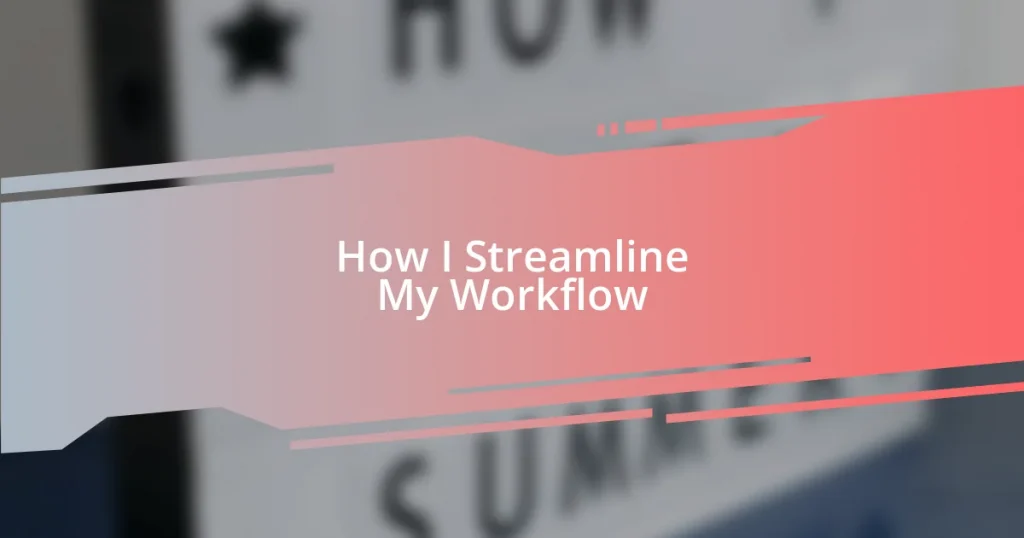Key takeaways:
- Identifying workflow bottlenecks involves reflecting on communication, gathering feedback from team members, and recognizing how small delays can significantly impact progress.
- Setting clear goals is essential for maintaining direction and motivation; regular review and adjustment of these goals can enhance overall productivity.
- Establishing a balanced work-life approach through boundary-setting, taking breaks, and scheduling leisure activities can boost both productivity and personal satisfaction.
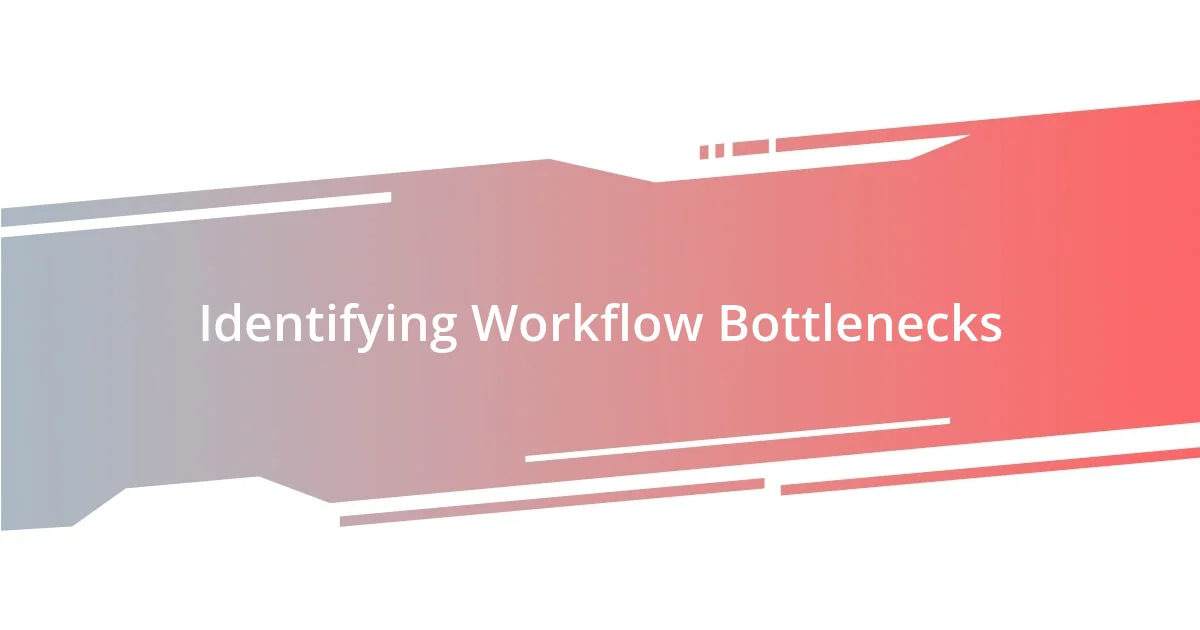
Identifying Workflow Bottlenecks
Identifying workflow bottlenecks is like being a detective in your own process. I remember a time when I felt stuck in a project, and every time I tried to make progress, something halted my momentum. Could it have been a lack of clear communication with my team? Reflecting on that experience helped me realize how crucial it is to examine where the flow stutters.
Sometimes, bottlenecks can be hidden in plain sight, masquerading as minor delays. I once assumed that waiting for approvals was just part of the routine. However, when I mapped out my tasks, I saw how often this caused significant setbacks. Have you ever felt that frustration? It’s enlightening to connect those dots and recognize that small issues can have a big impact on the overall workflow.
Another tactic I’ve found effective is to ask for feedback from others involved in the process. I once held a quick meeting where I invited team members to highlight what slowed them down. Their insights were eye-opening, revealing areas I never considered. It’s comforting to know that sharing challenges can lead to solutions. What if you reached out and discovered a way to streamline your own workflow as a result?
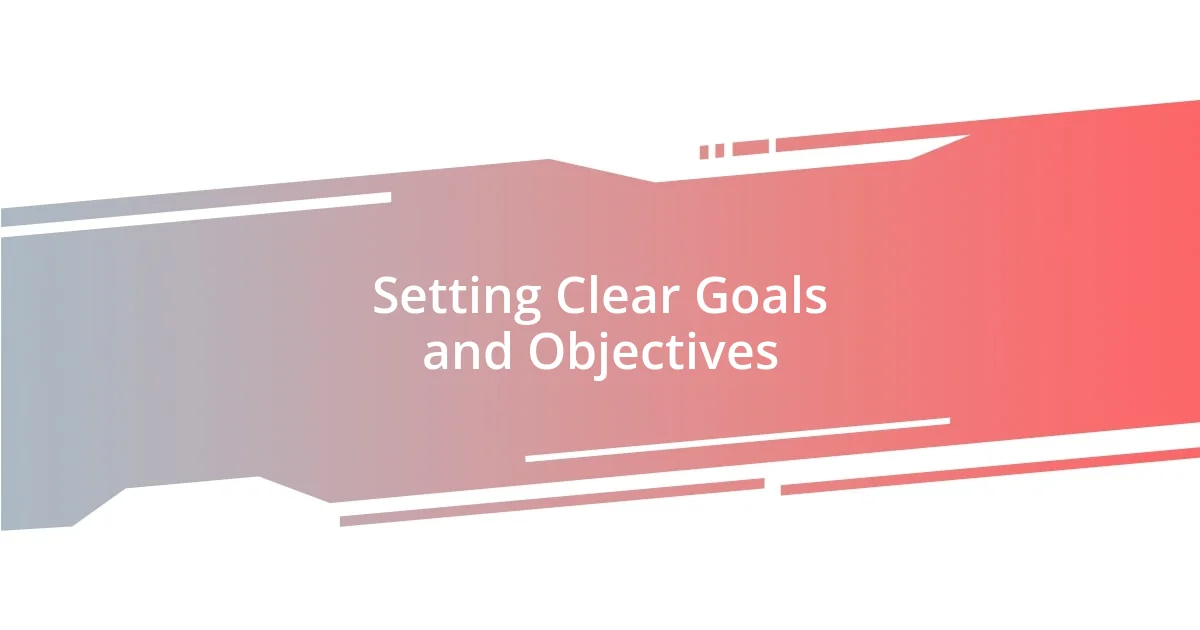
Setting Clear Goals and Objectives
Setting clear goals and objectives is fundamental to streamlining any workflow. From my experience, having well-defined targets gives direction and purpose. For example, when I started a major project without specific milestones, I quickly found myself adrift. The moment I broke down the project into smaller, actionable objectives, everything changed. I could see progress and stay motivated.
I’ve often compared goal-setting to drawing a map for a road trip. Without a map, I might end up lost or taking unnecessary detours. Just last month, I faced a situation where setting clear, measurable objectives early on allowed me to spot potential obstacles on my way to success. It transformed the way my team approached the tasks. We could better allocate resources and time, leading to a smoother and more enjoyable journey.
In my experience, it’s crucial not only to set goals but also to review and adjust them as necessary. I remember leading a team project where initial objectives seemed right, but as we progressed, we realized they were misaligned with our ultimate vision. By revisiting those goals together, we found a renewed focus that energized the entire team. Have you ever revisited your goals? Sometimes, a little tweak can unlock a world of efficiency.
| Aspect | Without Clear Goals |
|---|---|
| Direction | Confused and scattered efforts |
| Motivation | Low enthusiasm and engagement |
| Resource Allocation | Inefficient use of time and manpower |
| Outcome | Uncertain results and delays |
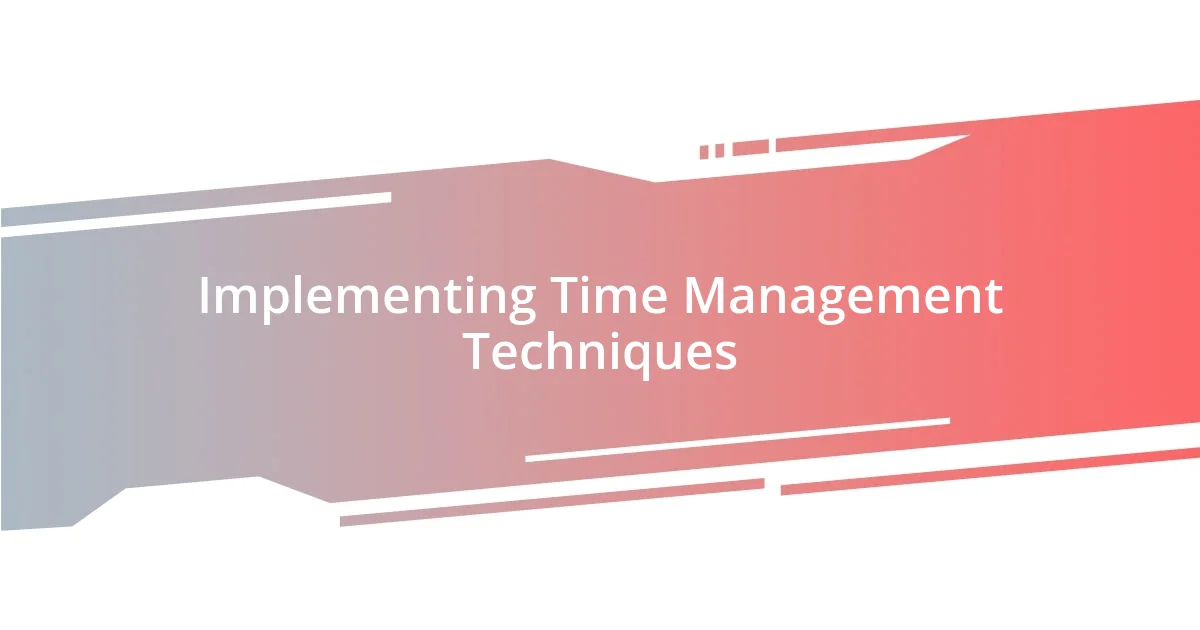
Implementing Time Management Techniques
Implementing Time Management Techniques
Adopting effective time management techniques has reshaped my approach to workflow. I remember a particularly hectic week when deadlines loomed large. That’s when I decided to try time-blocking—allocating specific chunks of my day to different tasks. It sounds simple, but it transformed my productivity. By clearly designating when I would focus on particular projects, I found it easier to fend off distractions and really dive into my work.
To make time management even more effective, I’ve integrated the Pomodoro Technique into my daily routine. This method involves working in short bursts, followed by quick breaks. I experienced a significant boost in my concentration when I devoted 25 minutes solely to a single task before taking a five-minute breather. Here’s how I apply it:
- Set a timer for 25 minutes: This creates urgency and focus.
- Take a 5-minute break: Stand up, stretch, or grab a drink—clear your mind.
- Repeat for four cycles: After four Pomodoros, take a longer break (15-30 minutes).
This strategy not only kept my momentum going but also helped me recharge frequently, which was especially refreshing during those long workdays. Have you noticed how a little structure can change your mindset? It’s fascinating how implementing just a few techniques can lead to a more manageable and pleasant workflow.
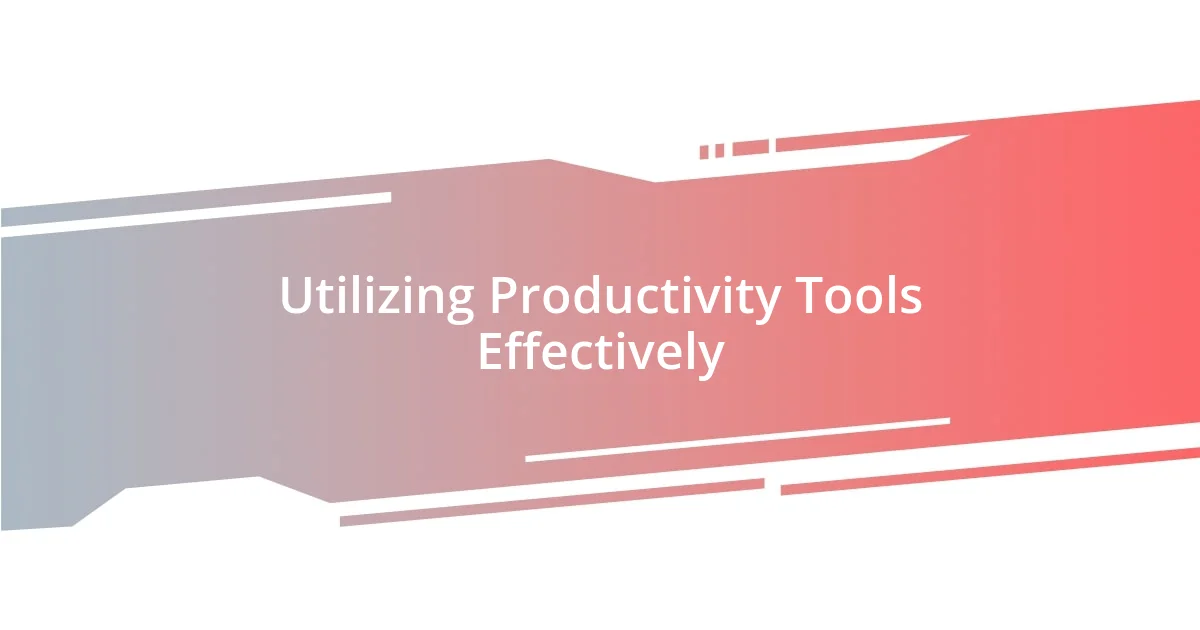
Utilizing Productivity Tools Effectively
Utilizing productivity tools can often feel overwhelming, but I’ve discovered ways to engage with them effectively. For instance, when I first tried using a project management tool, I was intimidated by its array of features. But once I started using it for simple tasks—like creating a to-do list—I began to see its true value. By taking small steps, I gradually explored the more complex functions, such as setting deadlines and assigning tasks, which allowed me to harness its full potential.
There’s a thrill that comes from finding the right tool that perfectly complements my workflow. Last year, I switched to a time-tracking app that transformed how I managed my projects. It not only helped me visualize where my time was going but also made me reflect on my habits. Have you ever tracked your time? I was astonished to discover I was spending too much time in meetings and not enough on actual work. This insight has motivated me to optimize my schedule, ensuring I allocate more hours to deep work that truly drives results.
Another key for me has been integrating tools seamlessly into my daily routine. I use automation to minimize repetitive tasks; for example, my email responses are often streamlined with templates. This small change has led to significant time savings, so I can focus on what matters. Imagine freeing up even just an hour a week—what could you accomplish with that extra time? Embracing automation not only keeps my workflow smooth but also eases that mental load, allowing me to breathe a little easier in a busy workweek.
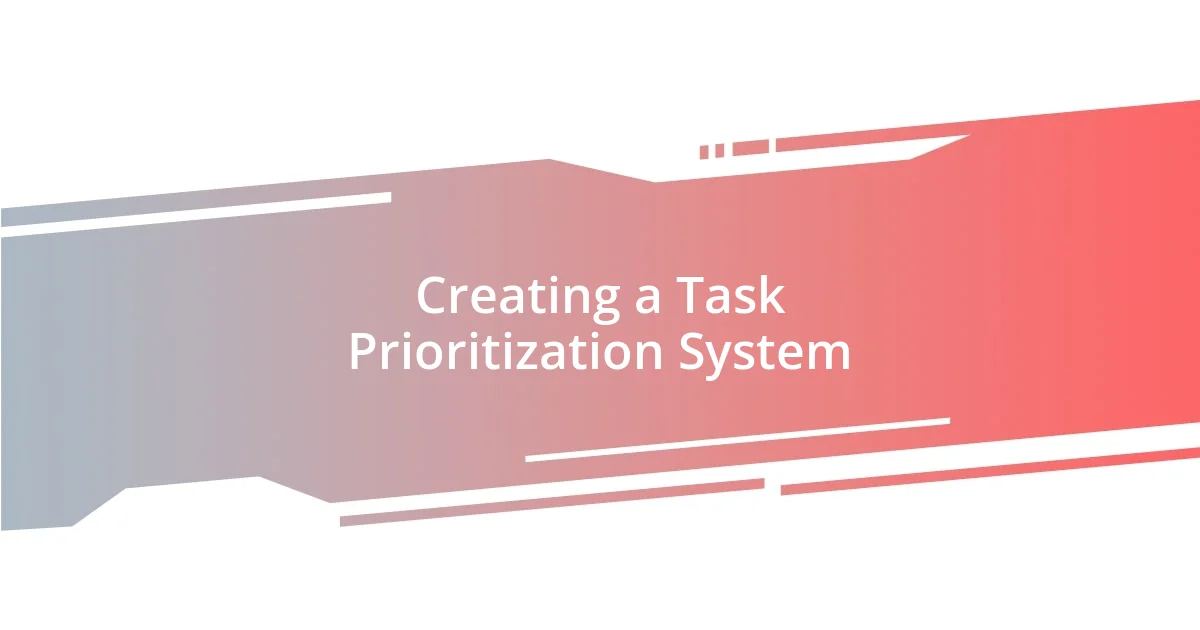
Creating a Task Prioritization System
Creating a task prioritization system was a game-changer for me. I began using the Eisenhower Matrix, which categorizes tasks into four quadrants based on urgency and importance. At first, I hesitated, thinking it would be too complicated, but once I mapped out my tasks, I quickly saw what needed immediate attention versus what could wait. It’s like looking at a messy room and knowing exactly where to start putting things in order.
Another aspect I embraced was the “One Thing” principle. Each morning, I ask myself, “What’s the one task that, if completed today, would make everything else easier or unnecessary?” Focusing on that single priority has skyrocketed my productivity. For instance, I remember tackling a major report due at the end of the week. By prioritizing that over less crucial tasks earlier in the week, I not only finished it ahead of time but also had reduced stress, allowing me to present it confidently.
I’ve also learned that flexibility is key in prioritization. Things often come up that shift my original plan. For instance, when a sudden meeting disrupts my workflow, I take a moment to reevaluate my list. Do I need to push a task to the following day or perhaps delegate it? This adaptability helps me maintain control without feeling overwhelmed. How do you handle surprises in your schedule? Finding ways to pivot has made my journey smoother and even more rewarding, giving me a sense of empowerment over my tasks.
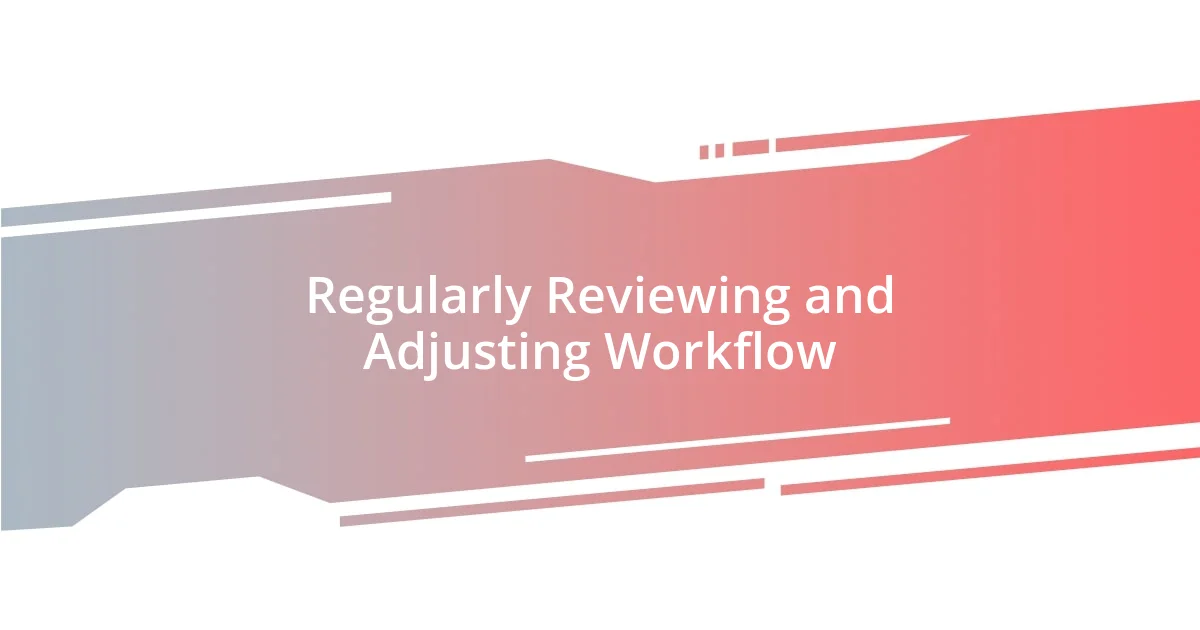
Regularly Reviewing and Adjusting Workflow
Regularly reviewing and adjusting my workflow has become a crucial part of staying productive. I set aside time each week to reflect on what went well and what didn’t. This practice got started when I noticed that tasks I thought I had perfected still took longer than expected. By examining my processes, I discovered that a minor change—like adjusting my meeting times—could save me hours of work.
I often find it helpful to establish a feedback loop with myself. At the end of this past month, I took a step back and evaluated how my new routines were impacting my overall performance. I realized that while my morning block of deep work was effective, the latter part of my day felt chaotic. This prompted me to shift to a lighter task schedule in the afternoons, allowing my energy to flow better throughout the day. Have you tried reflecting on your weekly successes? That simple analysis can help you maintain momentum and even spark new ideas for improvement.
Staying agile in my workflow is essential. When I embrace the unexpected, like an urgent task that drops in my lap, my workflow remains intact. For instance, I once had an unplanned client call that could have derailed my entire week. Instead of panicking, I adapted by rescheduling less urgent tasks. That single change not only preserved my productivity but also revealed the importance of flexibility. How do you typically react to unexpected changes in your routines? Finding the balance between structure and spontaneity has truly transformed my workload.
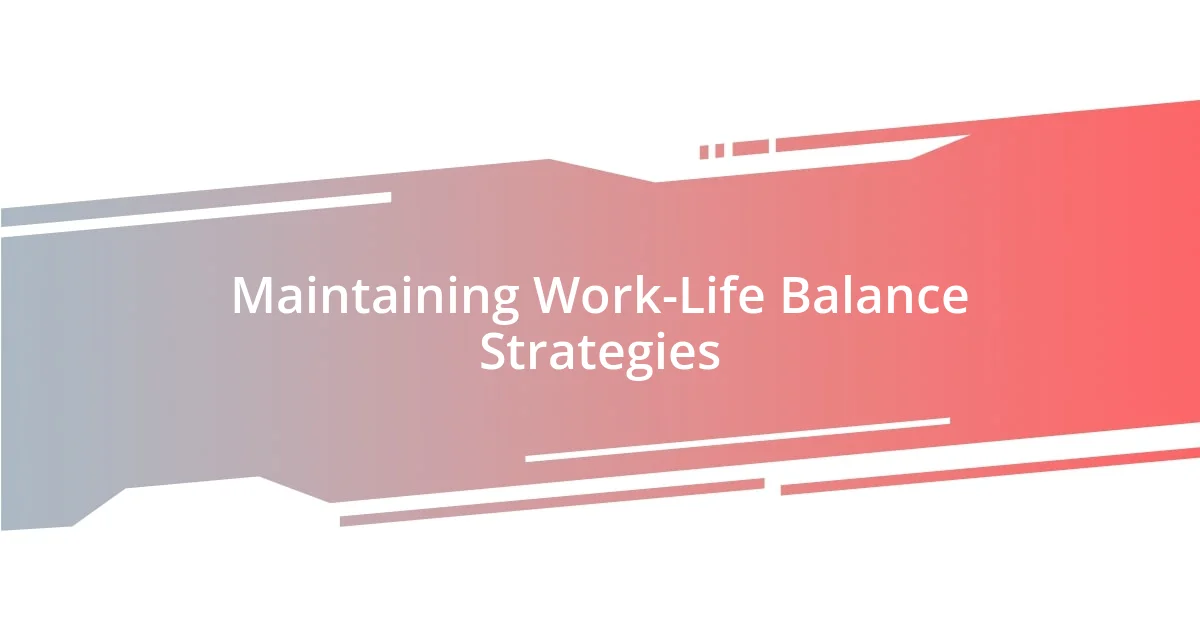
Maintaining Work-Life Balance Strategies
Maintaining a healthy work-life balance doesn’t just happen; it’s something I intentionally cultivate. One strategy that truly resonates with me is setting clear boundaries. I used to answer emails late at night, thinking it was just part of the job, but I soon realized it drained my energy and intruded on my personal time. Now, I’ve developed a hard stop at 6 PM, which creates a refreshing distinction between work and home life. How do you set your boundaries? Reflecting on this can honestly reshape your day-to-day experiences.
Taking regular breaks during my workday has also been a game-changer. I never thought stepping away from my desk could boost my productivity so dramatically. However, I found that a quick 10-minute walk or simply stretching can recharge my mind and creativity. When I return, I often tackle tasks with renewed focus. Have you ever noticed how a short break can lead to breakthroughs in thinking? I encourage you to try it out—your brain deserves a little time off!
Another aspect of balance I swear by is intentional leisure time. Once, I focused solely on work, believing it would lead to success. But I eventually felt burnout creeping in. I began scheduling activities that genuinely bring me joy, like painting or planning weekend hikes. This has not only improved my mood but also made me more productive during work hours. Have you carved out time for what ignites your passion? Embracing those moments has made all the difference for me and serves as a vital reminder that life is not just about work but also about enjoying the journey.










